Balanced Body, Balanced Life:
Yoga Poses for Creating Harmony and Flow in Your Everyday Life
BY MATT COOKE
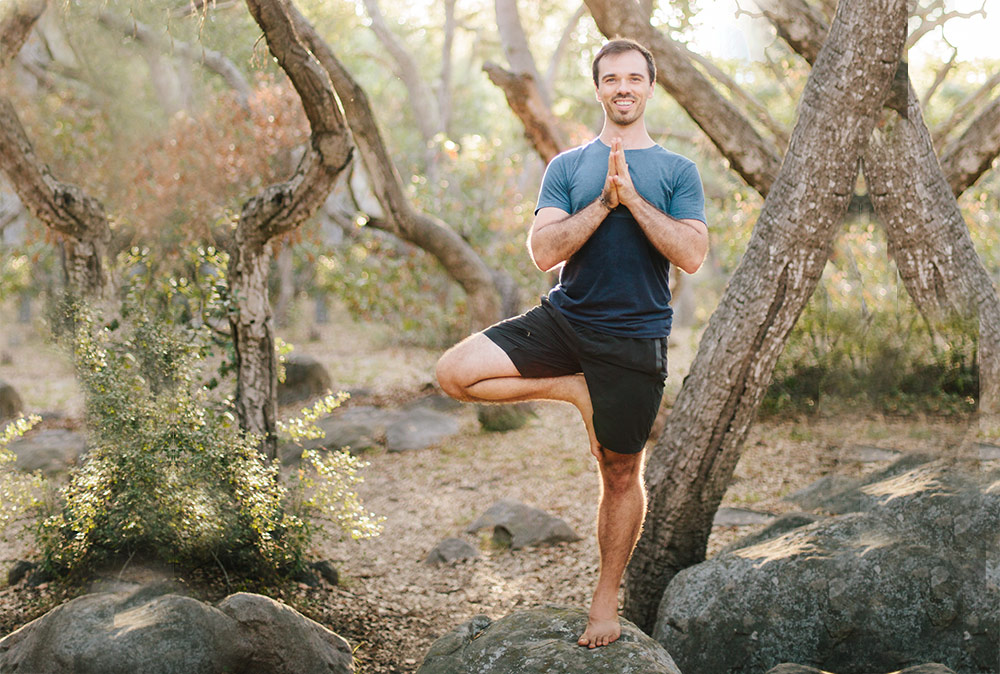 practicing balancing yoga poses helps create a balanced body, which is integral for creating a harmony and flow. photo: lerina winter
practicing balancing yoga poses helps create a balanced body, which is integral for creating a harmony and flow. photo: lerina winter
Balance yoga looks different to all of us. Our lives require dynamic shifts in balance depending on the season, the year, or even the decade we find ourselves moving through. This includes but is not limited to our
relationships, our career path, our health and, quite frankly, any other area of our life; all of it is fair game. A balanced life is, in fact, so essential to our wellbeing that the ancient yogis, rishis, and swamis of India devised a 5,000-year-old science and system of balance yoga called Ayurveda. Needless to say, the discussion and history of balance is rich and varied across the ages.To tie things back to your body and your balance yoga practice, what I recommend for modern yogis is for the focus to rest strongly on the asana practice—the balanced body being a microcosm and reflection of our life. By properly stacking the muscles and bones, we work towards more efficiency, effortlessness, and balance in our movements on and off the mat.
We often step onto the yoga mat with the intention of working toward “good alignment,” but this is a double-edged sword. Where we can go wrong as yogis in striving for balance yoga is by attempting to “over-fix” our tight areas rather than focusing on harmonizing our system and looking for clarity and freedom of movement. Because our body is an unconscious reflection of both our conscious and unconscious psychology, as we become freer and less restricted in our breathing and movement, it elicits a corresponding deeper opening in our psychology. We become less restrictive and dogmatic in our thinking, allowing us to perceive and dance with the duality of our existence—seeing the ever-evolving, ever-changing nature of all things. This balanced life helps us move from seeing things only in “black or white” to being open and receptive to all aspects and shades of life, bringing us into compassion and acceptance for ourselves and others; ultimately, transcending the limited ideas of right and wrong in favor of a greater evolutionary wisdom and, perhaps most importantly, to truly find the balance that is appropriate for us in the moment. A balanced body, therefore, may look very different from one body to the next. Yoga poses are meant to be dynamic, not rigid, and to truly unravel and open as we seek to find the harmony inside of our bodies. In your practice, look to find what feels good on the inside rather than what looks good on the outside. We are always our own best yoga teachers.
Taking Balance Too Far
As we begin our yoga practice, we find areas of tension in the body and barriers to movement, which are often highlighted by a teacher, reflected to us vividly by a mirror, or noticed as we observe differences in our bodies compared to those practicing around us and decide we are not adequate enough. We either then stop practicing balance yoga or our mental pattern begins to loop on the “dysfunction” rather than paying attention to our anatomy on the given day and turning our focus to making incremental openings in the body—which is the real goal of the practice. Instead we start to over-correct, eventually leading to dysfunction on the opposing side and swinging us even further out of a balanced life. We begin to lose the essence of yoga; to sync up and integrate our moment-to-moment awareness of our body and thoughts. At least that’s my perspective on the art—my goal with my practice being to use my mind in conjunction with my balanced body to consistently bring them both into harmony moment by moment.
When we seek a balanced life through harmony as a feeling rather than what our minds tell us is right, we allow for exactly what is. Harmony brings about equanimity, whereas balance, especially when we try and find it through the mind, can be seen in many bodies as an anatomical and behavioral adjustment that “must be made,” for instance, “I’m broken and must be ‘fixed.’”
The balance yoga practice then becomes unconscious and dogmatic, as we slavishly try to fix ourselves, acting from a wounded place rather than tuning into the information supplied by our beautiful body and mind that we walked onto the mat with that day, which is always nudging us to find harmony. In those situations, what is out of balance is our sense that there is something wrong with me—that we are anything less than perfect just as we are and must be fixed.Finding Balance: The Harmonious Way
So what’s a harmony-seeking, out-of-balance yogi to do? The method I use with my clients is as follows:
Cultivate Awareness
Explore and get acquainted with your body that day. Like an old friend you haven’t seen for awhile, you’re familiar but want to catch up on all the updates since you last spoke—to hear all the details you’ve missed in your time apart. Try to truly see and admire all the stuck places, all the open places.
Practice Acceptance
Take time to reflect and take stock of exactly where your body (and mind) is on that day. Appreciate and accept exactly where it is, without judgment, honoring the wisdom of the self in that moment, which is honestly the bulk of the balanced life practice and the most beautiful. To find acceptance we must be fully connected to the body—mentally and physically—and what it is telling us. It probably won’t make any rational sense, because the body generates feelings and images, not fully cognized sentences. So go easy on yourself as you begin to listen, and don’t dismiss any of the information that arises. It’s gold. Write it down if you feel called to do so and study it later. Acceptance allows for the full integration of the balanced body and mind. Acceptance touches deep mental and emotional places as we gain awareness of how long our body has moved or felt a certain way. Be light and easy with yourself.
Possible Pitfall: No rejection of the body allowed. It’s really easy to deny parts of ourselves here, ignoring a pattern or pushing away and rejecting what we don’t like, or my favorite: to “control” or “muscle it” back to health.
That’s how we got into the pattern of dysfunction, disharmony, and imbalance in the body in the first place. Instead think: tender loving care, just like you’d love a child. In fact, our unresolved childhood emotions get stored in our bodies and form protective muscular patterns called samskaras in yoga, which cause us to tighten or freeze. Take your time and move slowly, making sure to catch all the details as you explore balance yoga.
Inspired Movement
With all of that juicy, accepted information: move into your balance yoga. Move to your heart’s content, slowly stretching and breathing open all the nooks and crannies, continuing to not resist what’s happening in your body, nor how quickly or slowly it’s opening.
The key wisdom here is that the balanced body does not speed up healing and opening for anyone. Your body is part of nature, and it moves in its own cycles and rhythms, as does nature. It can’t be rushed.
Our body is an unconscious reflection of our consciousness. So, as we try to control our anatomy, we are also unconsciously trying to control outside circumstances and people. When we view our anatomy as wrong or bad and attempt to control it, it turns an acute dysfunction into more deeply held muscular tension. This holding on to believing that something is wrong and needs to be fixed leaves us in pain and further disconnected from ourselves, our balanced bodies, and our loved ones. As my friend and coach Brandon Hawk says: “What we resist, persists.”So, take time with your body today. Lie on your mat and ask: “What would harmony feel like in my body?” Let that guide your balance yoga movement and practice. This is the key to a truly balanced life. Going within, noticing what parts feel stiff and what parts easily receive breath, and then working with them organically and somatically to determine what needs to happen. Yoga teacher, mirror, or other yogis be damned!
Balance Yoga Tree Pose (Vrksasana)
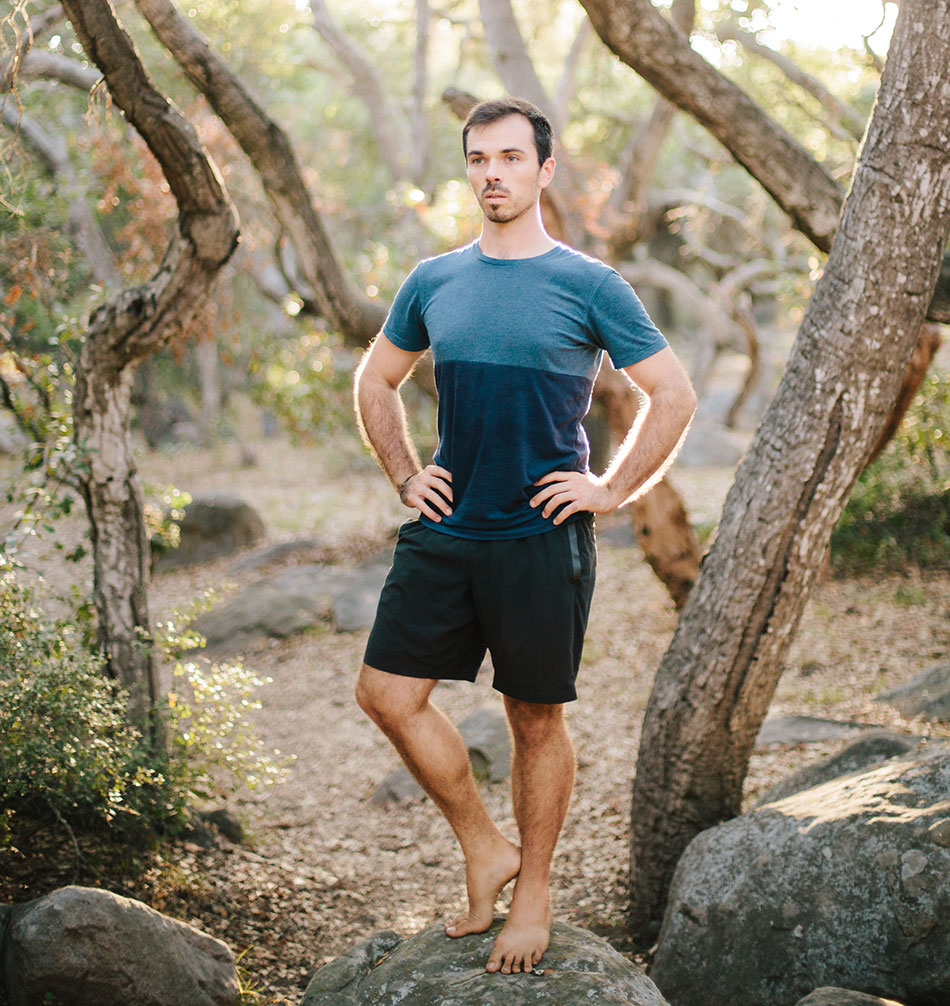
1-2. Stand with both feet flat on the ground about hip width apart. Place your hands on your hips. Rock your weight firmly onto your left leg and left side of your body. Find stability in the leg. Gently externally rotate your right hip open and rotate on the ball of your right foot.
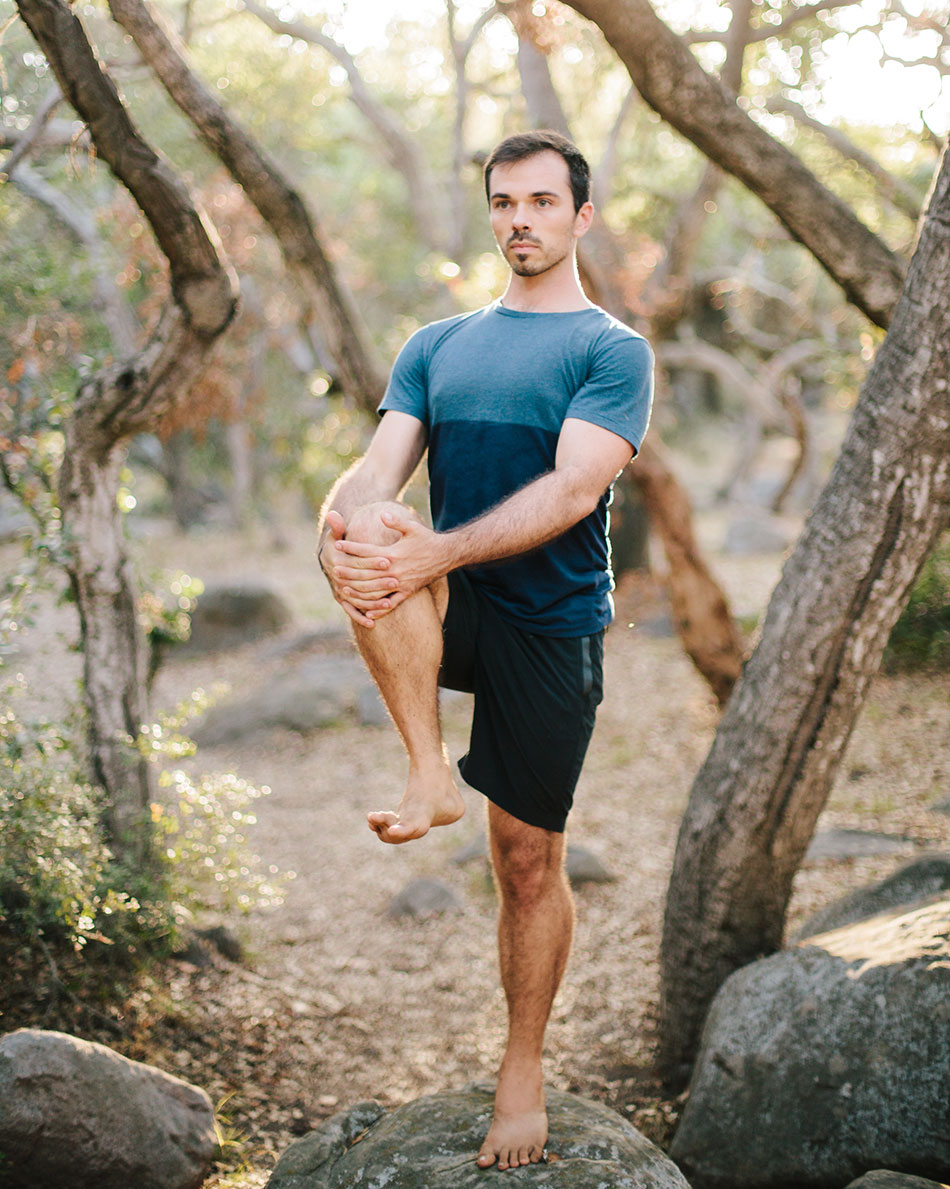
3. Gracefully slide your right foot up your shin. Continue to slide the foot past the knee joint, up your inner thigh (optional). Once you arrive in the pose, settle your weight again in the left leg. Lengthen your tailbone toward your left heel, lift your lower belly, and widen your bent knee.
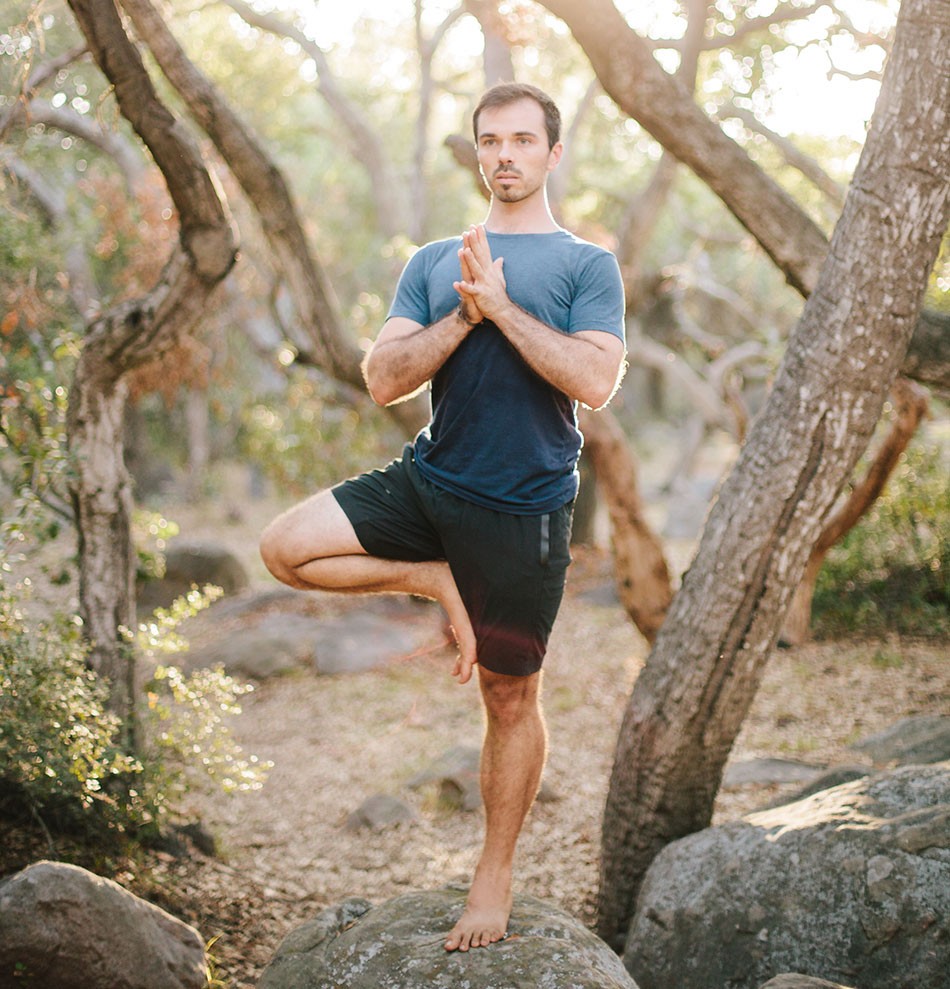
4-5. On an inhale, lift your arms above your head. Broaden your chest, and draw your shoulder blades down your back. Breathe deeply for 5 breaths. Notice in this “balancing” pose that, when balancing on each leg, we are anything but balanced. Instead, we strive to maintain equanimity in our whole balanced body: a sense of rootedness while being in the chaos. Repeat the entire sequence on the other side.
Cat-Cow Pose (Chakravakasana)
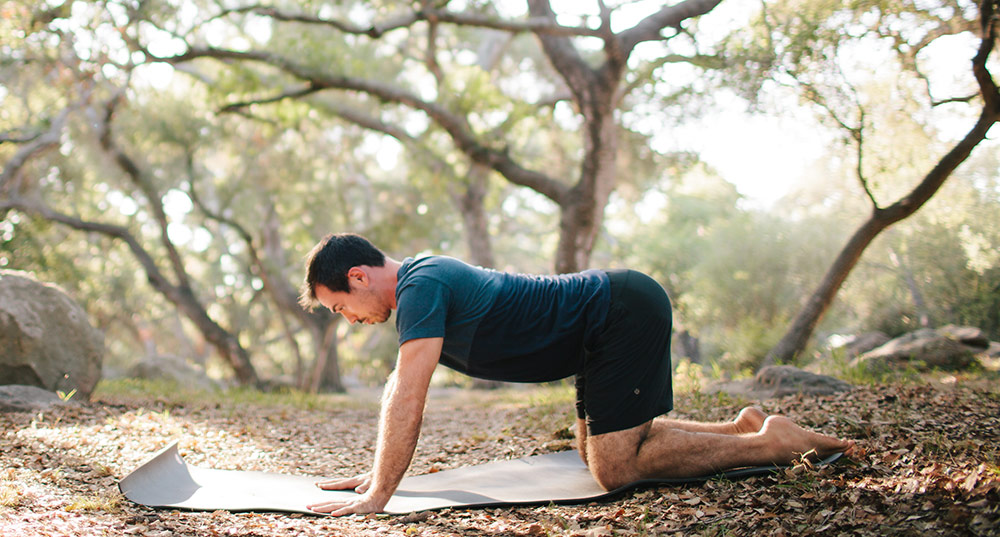
1. Move gently while trying to balance your body: Climb onto all fours; stack your knees under your hips and your wrists underneath your shoulders. Inhale and drop your belly, lift your chest, and lift your tailbone high.
2. Exhale, round your spine in, dome your upper back. Slowly reverse your cat/cow movement.
3. Move 5 to 10 times, inhaling to lift your chest and exhaling to curl inward. (For more on turning inward check out my article “Slowing Down: Yoga to Shift Your Consciousness” in the previous issue)
4. Soak in the movement, noticing your neck, your upper back, and shoulder blades. Notice your middle back and all the tiny muscles running along your spine, which support you to move so effortlessly.
About The Author
Matt Cooke is a neuroscience-based yoga teacher (500 RYT), author, and High Performance Coach who uses movement to unleash high performance for burnt out tech entrepreneurs. Matt studied extensively with Noah Maze and Elena Brower and his work is infused with Kripalu, Iyengar, and several coaching methodologies. Having conducted workshops and seminars all over the world, Matt is impassioned to inspire action and embodiment off the yoga mat. To learn more about Matt or get in touch with him, visit his website: matcooke.yoga























